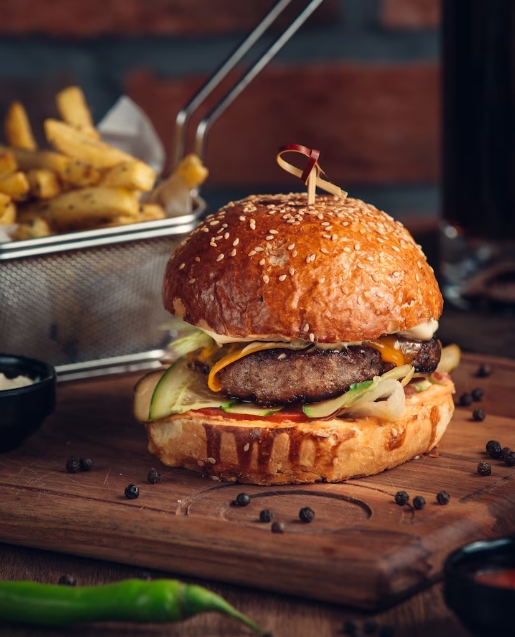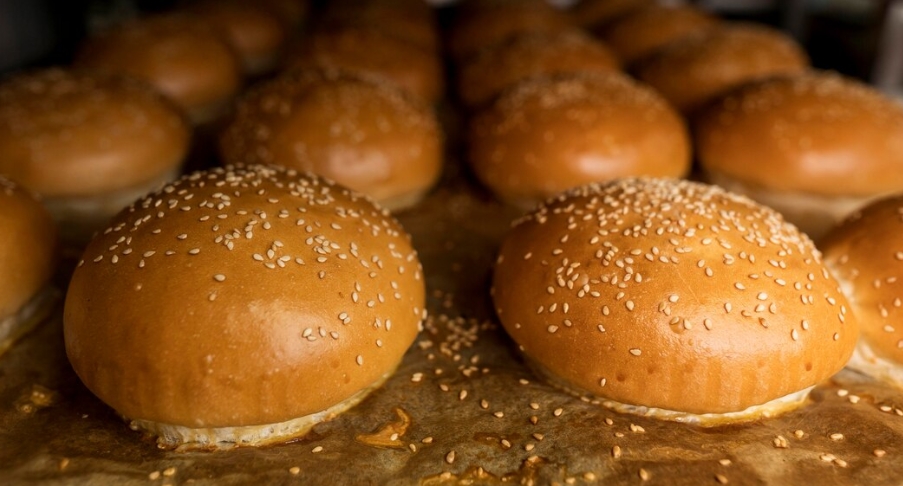Note
- For a juicier burger, use ground beef with 20% fat.
- Customize your toppings to suit your taste—add avocado, bacon, sautéed mushrooms, or spicy jalapeños.
- Avoid pressing down on the patties while cooking to retain their juices.
Journey of Hamburger
From Hamburg to the Heart of America.
The hamburger originated in Hamburg, Germany, a city noted for its ports and lively trade in the nineteenth century. Sailors and merchants carried with them stories about Hamburg steak, a simple yet delectable preparation of ground beef seasoned with salt, onions, and spices. This dish immediately became popular, particularly among visitors who enjoyed its rich flavor and hearty nature.
When German immigrants sailed for the United States, they brought with them the flavors of their homeland, including the popular Hamburg steak. This cuisine would undergo a dramatic transition in their new home, eventually becoming what we know as the hamburger.
Birth of an Icon
The hamburger as we know it now is thought to have originated in the late nineteenth century. While its actual origin is debatable, many attribute its inception to the necessity for convenience during the fast-paced industrial period. A simple yet brilliant idea—putting a Hamburg steak between two slices of bread—made it portable, inexpensive, and accessible to workers on the road.
The 1904 St. Louis World's Fair was essential in popularizing the hamburger, presenting it to a larger audience. By the 1920s, the hamburger had become a fixture in American diners and fast-food restaurants, thanks in part to White Castle, the first fast-food hamburger business.
A global sensation.
The hamburger voyage did not end in America. Its simplicity and versatility enabled it to tour the world while adjusting to local tastes and traditions. In Japan, teriyaki sauce and rice buns give the hamburger a distinct flavor. Spiced vegetable or chicken patties are popular in India because they meet local dietary preferences. In Mexico, burgers are typically topped with avocado, jalapeños, and spicy salsa.
No matter where you travel, the hamburger remains a popular comfort food, reflecting each culture's culinary originality.
The Art of Patty
Every perfect hamburger starts with a patty. The type of meat, flavor, and cooking technique all play an important role in achieving the ideal bite. Traditional beef patties with an 80/20 fat ratio are valued for their juiciness and flavor, although alternatives such as turkey, lamb, and plant-based options have grown in favor in recent years.
Cooking methods also differ, with grilling being the most preferred due to its smoky flavor. Whether cooked on a backyard barbecue or in a cast-iron pan, the patty serves as a foundation for the subsequent layers of toppings.
Customization: Hamburger's Secret to Success
The hamburger's allure stems from its almost limitless customizing options. There's a hamburger for every taste, from conventional toppings like lettuce, tomato, and cheese to gourmet options like truffle aioli, caramelized onions, and avocado. Even the bun is a blank canvas for imagination—brioche, pretzel, sesame seed, and gluten-free alternatives cater to a variety of tastes and dietary requirements.
Modern-day Burgers
The hamburger has gone a long way since its humble beginnings. Gourmet burger places and fast-food businesses continue to innovate, serving everything from towering piles of patties to slider-sized pieces. The advent of plant-based meat alternatives, such as Beyond Meat and Impossible
Burger has elevated the hamburger to the forefront of sustainable dining, appealing to vegetarians, vegans, and eco-conscious eaters.
Fun Facts about Hamburgers
- Americans eat an estimated 50 billion hamburgers each year.
- The heaviest hamburger ever created weighed more than 2,000 pounds and needed a crane to flip.
- The first hamburger in orbit was eaten aboard the International orbit Station in 2001.
Why Do We Love Hamburgers?
The hamburger's continuing appeal stems from its simplicity and versatility. It's a dish that brings people together, whether at a backyard barbecue, a fast-food drive-thru, or a high-end restaurant. It represents comfort, nostalgia, and the enjoyment of sharing a meal.
Thank you for following me on this journey through the history and evolution of hamburgers.






